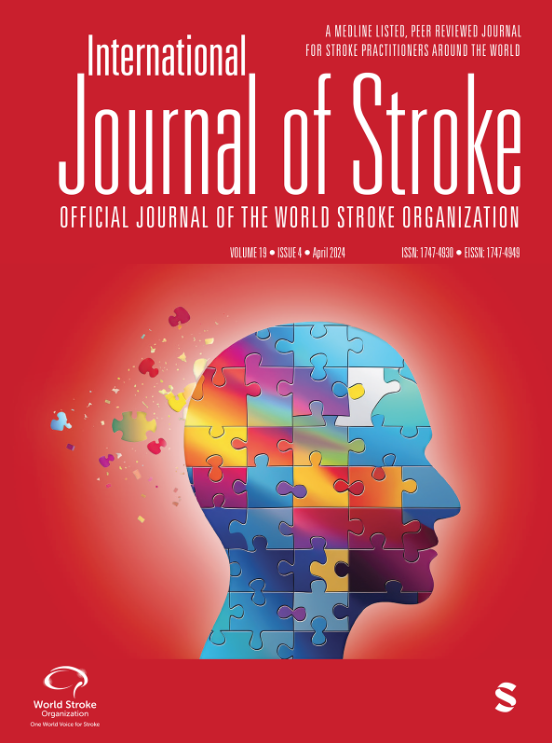Validation of a Simple Clinical Tool for Screening of Acute Lacunar Stroke – a substudy of the WAKE-UP trial
IF 6.3
2区 医学
Q1 CLINICAL NEUROLOGY
引用次数: 0
Abstract
Introduction:Lacunar stroke represents around a quarter of all ischemic strokes, however, their identification with Computed Tomography in the hyperacute setting is challenging. We aimed to validate a clinical score to identify lacunar stroke in the acute setting, independently, with data from the WAKE-UP trial using magnetic resonance imaging.Methods:We analysed data from the WAKE-UP trial and extracted Oxfordshire Community Stroke Project (OCSP) classification. Lacunar score was defined by NIHSS<7 and OCSP lacunar syndrome. Assessment of lacunar infarct by two independent investigators was blinded to clinical data. We calculated sensitivity, specificity, negative and positive predictive value (NPV and PPV, respectively) of lacunar score.Results:We included 503 patients in the analysis, mean (±SD) age 65.2 (±11.6), 325 (65%) males, median (IQR) NIHSS=6 (4-9); 108 (22%) lacunar infarcts were identified on MR, patients fulfilling lacunar score criteria were 120 (24%), of which 47 (44%) had a lacunar infarct. Lacunar score correctly identified 322 (82%) of patients without lacunar infarct. Patients with lacunar score had lower NIHSS (4 vs 7,p<0.001), higher systolic (157 mmHg vs 151 mmHg,p=0.001) and diastolic (86 mmHg vs 83 mmHg,p=0.013) blood pressure and smaller infarct volume (2.4 ml vs 9.5 ml,p<0.001). Performance of lacunar score was: sensitivity 0.44; specificity 0.82; PPV 0.39; NPV 0.84; accuracy 0.73. Assuming a prevalence of lacunar stroke of 13%, PPV lowered to 0.30 but NPV was 0.90. Lacunar score performed better for supratentorial lacunar infarcts.Conclusions:Lacunar score had a very good specificity and NPV for screening of lacunar stroke. Implementation of this simple tool into clinical practice may help hyperacute management and guide patient selection in clinical trials.用于筛查急性腔隙性脑卒中的简易临床工具的验证--WAKE-UP 试验的子研究
导言:腔隙性脑卒中约占所有缺血性脑卒中的四分之一,然而,在超急性期使用计算机断层扫描识别腔隙性脑卒中具有挑战性。方法:我们分析了 WAKE-UP 试验的数据,并提取了牛津郡社区卒中项目(OCSP)的分类。腔隙评分由 NIHSS<7 和 OCSP 腔隙综合征定义。由两名独立研究人员对临床数据进行盲法评估。我们计算了腔隙评分的敏感性、特异性、阴性预测值和阳性预测值(分别为 NPV 和 PPV)。结果:我们纳入了 503 名患者进行分析,平均(±SD)年龄为 65.2(±11.6)岁,325(65%)名男性,中位数(IQR)NIHSS=6(4-9);108(22%)名患者在 MR 上发现了腔隙性梗死,120(24%)名患者符合腔隙评分标准,其中 47(44%)名患者有腔隙性梗死。在没有发生腔隙性梗死的患者中,322 人(82%)的腔隙评分正确。有腔隙评分的患者 NIHSS 较低(4 vs 7,p<0.001),收缩压(157 mmHg vs 151 mmHg,p=0.001)和舒张压(86 mmHg vs 83 mmHg,p=0.013)较高,梗死体积较小(2.4 ml vs 9.5 ml,p<0.001)。腔隙评分的灵敏度为 0.44;特异度为 0.82;PPV 为 0.39;NPV 为 0.84;准确度为 0.73。假设腔隙性卒中的发病率为 13%,则 PPV 降至 0.30,但 NPV 为 0.90。结论:Lacunar 评分在筛查腔隙性卒中方面具有很好的特异性和 NPV。结论:Lacunar 评分对腔隙性卒中的筛查具有很好的特异性和 NPV,将这一简单的工具应用于临床实践可能有助于超急性期管理并指导临床试验中的患者选择。
本文章由计算机程序翻译,如有差异,请以英文原文为准。
求助全文
约1分钟内获得全文
求助全文
来源期刊

International Journal of Stroke
医学-外周血管病
CiteScore
13.90
自引率
6.00%
发文量
132
审稿时长
6-12 weeks
期刊介绍:
The International Journal of Stroke is a welcome addition to the international stroke journal landscape in that it concentrates on the clinical aspects of stroke with basic science contributions in areas of clinical interest. Reviews of current topics are broadly based to encompass not only recent advances of global interest but also those which may be more important in certain regions and the journal regularly features items of news interest from all parts of the world. To facilitate the international nature of the journal, our Associate Editors from Europe, Asia, North America and South America coordinate segments of the journal.
 求助内容:
求助内容: 应助结果提醒方式:
应助结果提醒方式:


